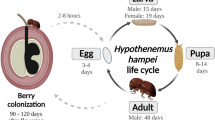Abstract
Prickly acacia, Acacia nilotica subsp. indica (Benth.) Brenan, a major weed of the Mitchell Grass Downs of northern Queensland, Australia, has been the target of biological control projects since the 1980s. The leaf-feeding caterpillar Cometaster pyrula (Hopffer) was collected from Acacia nilotica subsp. kraussiana (Benth.) Brenan during surveys in South Africa to find suitable biological control agents, recognised as a potential agent, and shipped into a quarantine facility in Australia. Cometaster pyrula has a life cycle of approximately 2 months during which time the larvae feed voraciously and reach 6 cm in length. Female moths oviposit a mean of 339 eggs. When presented with cut foliage of 77 plant species, unfed neonates survived for 7 days on only Acacia nilotica subsp. indica and Acacia nilotica subsp. kraussiana. When unfed neonates were placed on potted plants of 14 plant species, all larvae except those on Acacia nilotica subsp. indica and Acacia nilotica subsp. kraussiana died within 10 days of placement. Cometaster pyrula was considered to be highly host specific and safe to release in Australia. Permission to release C. pyrula in Australia was obtained and the insect was first released in north Queensland in October 2004. The ecoclimatic model CLIMEX indicated that coastal Queensland was climatically suitable for this insect but that inland areas were only marginally suitable.
Similar content being viewed by others
References
Briese D.T., Walker A., Pettit W.J., Sagliocco J.L. (2002). Host-specificity of candidate agents for the biological control of Onopordum spp. thistles in Australia: an assessment of testing procedures. Biocontr. Sci. Tech. 12(2):149–163
Mackey A.P. (1997). The biology of Australian weeds 29. Acacia nilotica ssp. indica (Benth.) Brenan. Plant Prot. Q. 12(1):7–17
Marohasy J. (1995). Prospects for the biological control of prickly acacia, Acacia nilotica (L.) Willd. ex Del. (Mimosaceae) in Australia. Plant Prot. Q. 10(1):24–31
Maslin B.R. (2001). Introduction to Acacia. Fl. Australia. 11A:3–13
Mohyuddin, A.I., 1981. Phytophages associated with Acacia nilotica in Pakistan and possibilities of their introduction into Australia. In: E.S. Del Fosse (ed), Fifth International Symposium on Biological Control of Weeds, CSIRO. pp. 161–166
A.E. Orchard and P.M. McCarthy (eds), (1998). Flora of Australia Volume 12, Mimosaceae (excl. Acacia), Caesalpiniaceae. CSIRO, Melbourne
Orchard A.E. and Wilson A.J.G. (eds), (2001a). Flora of Australia Volume 11A, Mimosaceae, Acacia Part 1. ABRS/CSIRO, Melbourne
Orchard A.E. and Wilson A.J.G. (eds), (2001b). Flora of Australia Volume 11B, Mimosaceae, Acacia Part 2. ABRS/CSIRO, Melbourne
Poole, R.W., 1989. Lepidopterorum Catalogus (New Series), fasc. 118, Noctuidae (3 Parts). E. J. Brill/Flora & Fauna Publications
Sutherst, R.W., 2003. Prediction of species geographical ranges. J. Biogeogr. 30(1–12)
Sutherst R.W. and Maywald G.E. (1985). A computerized system for matching climates in ecology. Agric. Ecosystems Environ. 13:281–299
Sutherst R.W., Maywald G.E., Bottomley W. and Bourne A. (2004). CLIMEX v2. Hearne Scientific Software, Melbourne, Australia
Thorp J.R. and Lynch R. (2000). The Determination of Weeds of National Significance. National Weeds Strategy Executive Committee, Launceston, Australia
Wapshere A.J. (1974). A strategy for evaluating the safety of organisms for biological weed control. Ann. Appl. Biol. 77:201–211
Wapshere A.J. (1975). A protocol for programmes for biological control of weeds. PANS 21(3):295–303
Acknowledgements
We wish to thank the staff of the South African Field Station (A.B. Witt, S. Docherty and H. Steenkamp) and staff of the Plant Protection Research Institute (S. Neser, R. Stals and H. Zimmermann) for undertaking the preliminary studies or administrative arrangements that made this study possible. Martin Kruger of the Transvaal Museum, Pretoria, provided expert identification of the insect and additional records about the insect’s distribution. Martin Honey of the British Natural History Museum, London, supplied information on the insect’s distribution. Bob Sutherst of CSIRO Entomology kindly advised on the CLIMEX model. The very considerable collection of plants used for host range testing was sourced and maintained by Michele Rogers. Cathy Lockett and Margie Robinson of the Tropical Weeds Research Centre, Charters Towers, reared and released the insect. Caroline Hauxwell, Queensland Department of Primary Industries & Fisheries, Indooroopilly, provided pathology diagnoses and advice.
Author information
Authors and Affiliations
Corresponding author
Rights and permissions
About this article
Cite this article
Palmer, W.A., Senaratne, K.A.D.W. The host range and biology of Cometaster pyrula; a biocontrol agent for Acacia nilotica subsp. indica in Australia. Biocontrol 52, 129–143 (2007). https://doi.org/10.1007/s10526-006-9003-y
Received:
Accepted:
Published:
Issue Date:
DOI: https://doi.org/10.1007/s10526-006-9003-y




